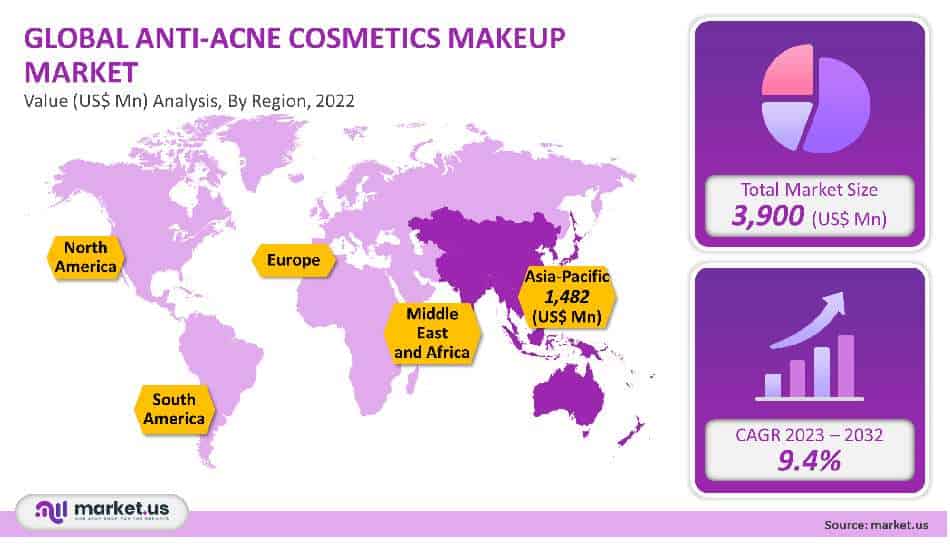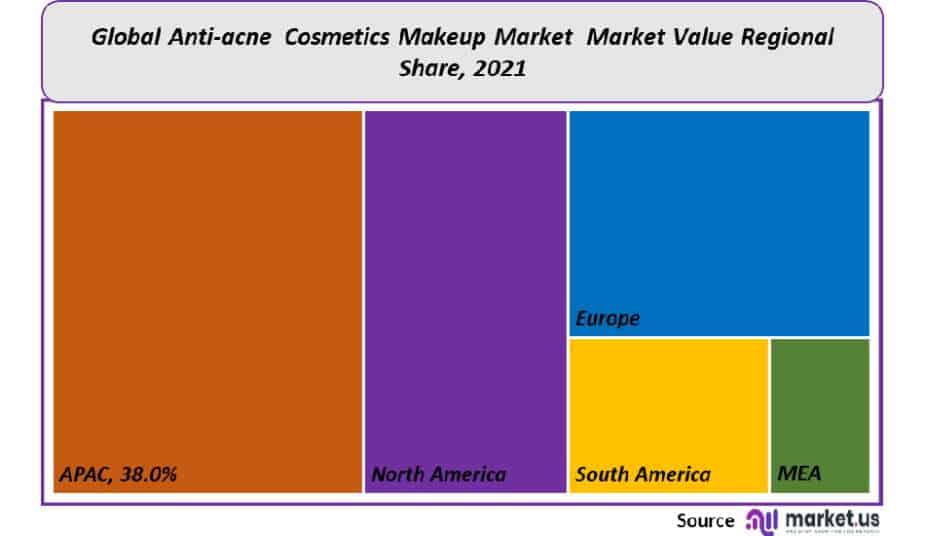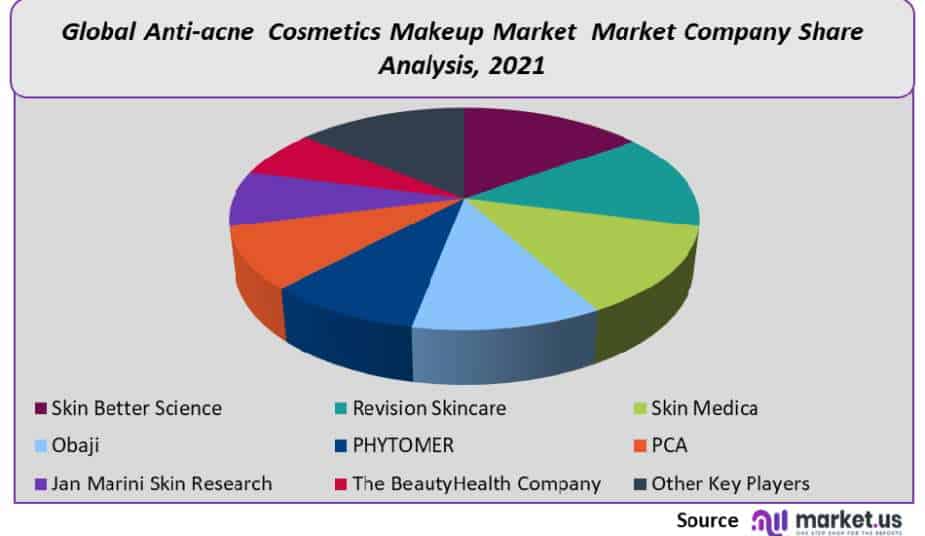Global Anti-acne Cosmetics makeup Market; By Product Type (Masks, Creams & Lotions), By Gender (Women, and Men); By End-Use (Dermatology Clinics, and MedSpa); as well as By Region and Companies - Industry Segment Outlook, Market Assessment, Competition Scenario, Trends and Forecast: 2023-2032
- Published date: March 2023
- Report ID: 18495
- Number of Pages: 242
- Format:
- keyboard_arrow_up
Quick Navigation
Report Overview
The Global Anti-acne Cosmetics makeup Market size is expected to be worth around USD 9.58 Billion by 2032 from USD 3.9 Billion in 2022, growing at a CAGR of 9.4% during the forecast period from 2022 to 2032.
The negative stigma attached to acne and the increased usage of cosmetics by both men and women, particularly in emerging economies, are predicted to be the main drivers for market expansion. The COVID-19 outbreak caused the aesthetics sector to suffer serious setbacks. Lockdowns forced the closure of retail stores, dermatology offices, and beauty parlors & medical spas in numerous nations. By 2020, internet sales of anti-acne makeup rose exponentially as a result of the lifting of COVID-19 restrictions.

Market Dynamics:
Market growth was accelerated by the fact that acne incidence increased during the pandemic. Acne is a common skin condition among adolescents. The Journal of The European Academy of Dermatology and Venereology published an article that stated that acne affects more than 95% of adolescents and nearly 85% of girls. Nearly 40% of those affected have moderate-to-severe skin conditions, and almost half continue to suffer from acne into adulthood.
Market growth is expected to be fueled by the high prevalence of acne in young people. Anti-acne products in the U.S. are expected to increase at a substantial CAGR between 2023 and 2032. Anxiety, depression, low self-esteem, and poor quality of life are all common issues for acne patients. These mental and emotional associations can be linked to an individual’s relationship with their appearance.
A study published in the International Journal of Women’s Dermatology found that women suffering from moderate or severe acne experience decreased self-esteem and embarrassment. These psychological issues will likely drive market growth by causing patients to seek cosmetic treatments to improve their appearance. The increasing use of photo editing and social media platforms indirectly fuels these psychological effects.
Driver:
Technological innovations are driving an increase in acne vulgaris prevalence
Acne is the most common skin-related problem in teenagers and all age groups. According to the American Academy of Dermatology Association acne is the most widespread skin condition. It affects approximately 40- 50 million people every year. According to U.K. government statistics, 95% of people suffer from acne between the ages of 11. and 30. Globally, anti-acne cosmetics market revenue is expected to rise due to rapid urbanization.
Market growth can also be attributed to technological advances in the production of anti-acne products. Galderma’s ‘Twyneo Cream’ was launched in the U.S. at the American Academy of Dermatology on 25 March 2022. Twyneo Cream, a 2-in-1 formulation containing 0.1% tretinoin (0.1% BPO) and 3% Benzoyl Oxide (3% BPO), has been effective in treating mild to severe acne. The patented microencapsulation technology combines these two previously unrelated chemicals. The controlled release is claimed to produce visible results in two weeks.
Companies are also taking different strategic initiatives in order to increase market penetration. Companies are now investing more in Research and Development (R&D), product launches, and upgrading existing product lines. Sun Pharmaceutical Industries, for example, reported on 26 July 2022 that their collaboration with Cassiopea regarding medicine for acne had been extended.
Cassiopea has granted the company the exclusive right to market WINLEVI throughout Japan, Australia New Zealand, Brazil Mexico, Mexico, Russia, and New Zealand. Cosmo will likely make the new acne treatment more accessible to patients in other countries. This is consistent with their strategy to build a global range of specialty products.
Restraint:
The easy availability of counterfeit products and rising awareness of side effects
Acne-prone skin can be sensitive and some cosmetics may make their condition worse. Experts from the American Academy of Dermatology say that patients suffering from acne can use makeup. Many people suffering from acne-related conditions don’t prefer to wear makeup, as their skin remains under medication. Some side effects of makeup for acne-prone skin include skin redness, increased sun sensitivity, dry and peeling skin, as well as skin rashes. Anti-acne cosmetics are not recommended by consumers. Anti-acne market growth is severely impacted by such stereotypes and beliefs.
A major reason for market revenue stagnation is also the existence of cheap counterfeit anti-acne cosmetic products. The skin of acne-prone people is extremely sensitive. When they purchase fake products, the condition becomes worsened which can lead to skin problems. The U.S. Department of State states that fake cosmetics can be found online as well as in pop-up shops across the country.
Many people are deceived into thinking they are buying genuine cosmetics by the frequent use of designer brands and camouflage. These products are fake and can contain harmful elements such lead, beryllium, or dangerous germs. The company claims that it will only sell La Roche-Posay products marked ‘Ships and Sold By Amazon.com’ in order to ensure customers are getting genuine La Roche-Posay products. This is Impact the revenue growth in anti-acne cosmetics.
Global Anti-Acne Cosmetics Makeup Market Scope:
Type Analysis
Masks, creams & lotions, and cleansers & toners are the three product categories that this market is segmented into. In 2021, creams & lotions accounted for 41.44% of this market’s total revenues. The strong demand for moisturizing creams is responsible for this. Users can buy these creams and lotions in medicated versions. These creams and lotions might include an API, vitamins like vitamin A, or drugs like antibiotics for acne brought on by bacterial infections. In addition to essential oils, other items include face washes, gels, and serums.
These products can aid in pore-clearing and inflammation reduction. Inflammation and blockage are frequent features of acne. These products come in a variety of forms depending on their components and intended application. Due to its adaptability to varied skin types and enhanced skin absorption, this market will expand quickly. Salicylic acid serums are well-liked since they are efficient at unclogging clogged pores and functioning as an anti-inflammatory.
They also aid in the breakdown of sebum (the oil responsible for acne). The National Center for Biotechnology Information (NCBI) claims that benzoyl peroxide is superior to 0.5% or 2% salicylic acid in the treatment of acne vulgaris.
Gender Analysis
Men and women are bifurcated into separate segments of this global market. The global anti-acne cosmetics market for women dominated the industry in 2021. More than 56.3% of total revenues came from this segment. Over the forecast period, it is anticipated that this category will continue to increase at the fastest rate and account for the majority of this market. This is a result of the fact that acne affects a lot of women. After puberty, hormonal changes like the menstrual cycle make acne more prevalent in women than in males. According to a survey, 61.8% of respondents said their acne got worse after they had their period.
The segment for men’s anti-acne cosmetics also retained a considerable market share in 2021. Hormonal shifts, poor hygiene, drug interactions, and bacterial infections are the most frequent causes of acne in men. Due to the increased incidence of acne among men, these products are in high demand. Nearly 42.1% of males, of which, 23% of men in their 30s, 11% of men in their 40s, and 7.1% of men in their 50s reported suffering from acne.
End-Use Analysis
This market can be divided into two categories based on end-use: Medspa and Dermatology Clinics. In 2021, the Medspa industry maintained a market share of 62.8%. This market size category is predicted to grow the most over the projected timeline. A medical spa offers aesthetic procedures under the supervision of a licensed doctor.
Medspas use technology to deliver state-of-the-art medical care. According to the American Spa Association, the U.S. Medspa industry has shown double-digit revenue growth since 2010. Most of Medspa’s clients were in the age range of 35 to 54.
Key Market Segments:
By Type
- Mask
- Creams & Lotions
- Cleansers & Toners
- Others
By Gender
- Women
- Men
By End-Use
- Dermatology Clinics
- MedSpa
Regional Analysis
With a revenue share of more than 38% in 2021, the Asia Pacific dominated this market. It is anticipated to grow profitably over the forecast term. The Asia Pacific is the biggest export market for American goods because there are potentially an estimated 3 billion users of anti-acne products in this region. According to a study published in JAMA Dermatology, acne is a common dead skin cell issue in Westernized nations like the US. Between 79 and 95% of the population are teenagers.
The top markets for American-made goods are Australia, Japan, and South Korea. Over the projection timeline, these products are expected to be sought after in Indonesia, Malaysia, Vietnam, and Malaysia. China is the most promising cosmetics market in the Asia Pacific Region. 80% of China’s cosmetics market can be chalked up to the Chinese people’s infatuation with Western brands.
According to Cosmetic Design, skincare has the fastest-growing market in China and indexes the most sales through online shopping channels. Active skincare product online Sales increased for businesses like L’Oreal China (China), increasing from 1% in 2013 to 18% in 2018.

Key Regions and Countries Covered in this Report:
- North America
- US
- Canada
- Mexico
- Europe
- Germany
- UK
- France
- Italy
- Russia
- Spain
- Rest of Europe
- APAC
- China
- Japan
- South Korea
- India
- Rest of Asia-Pacific
- South America
- Brazil
- Argentina
- Rest of South America
- MEA
- GCC
- South Africa
- Israel
- Rest of MEA
Market key companies are now more focused on pursuing key sustainable strategies such as mergers & acquisitions. L’Oréal Paris plans to make India its largest market for skincare products and cosmetics by acquiring Indian companies. L’Oreal announced in December 2020 that it had signed an agreement to purchase Takami Co., a premium Japanese skincare company. It is now responsible for the development and marketing of products licensed by Takami, a skincare brand owned by Doctor Hiroshi Takami. These are some of the most prominent companies in anti-acne cosmetics markets worldwide.

Market Key Players:
- Skin Better Science
- Revision Skincare
- Clinique Laboratories
- Vichy Laboratories
- Skin Medica
- Obaji
- Pca Skin
- PHYTOMER
- PCA
- Jan Marini Skin Research
- The BeautyHealth Company
- Other Key Players
For the Anti Acne Cosmetics Market research study, the following years have been considered to estimate the market size:
Attribute Report Details Market Size in 2022
USD 3.9 Billion
Growth Rate
9.4%
Forecast Value in 2032
USD 9.58 Billion
Historical Years
2016-2020
Base Year
2021
Estimated Year
2022
Short Term Projection Year
2028
Projected Year
2023
Long Term Projection Year
2032
Report Coverage
Competitive Landscape, Revenue analysis, Company Share Analysis, Manufacturers Analysis, Volume by Manufacturers, Key Segments, Key company analysis, Market Trends, Distribution Channel, Market Dynamics, COVID-19 Impact Analysis, strategy for existing players to grab maximum market share, and more.
Regional Scope
North America, Europe, Asia-Pacific, South America, Middle East & Africa
Country Scope
United States, Canada and Mexico, Germany, France, UK, Russia and Italy, China, Japan, Korea, India and Southeast Asia, Brazil, Argentina, Colombia etc.Saudi Arabia, UAE, Egypt, Nigeria and South Africa
Frequently Asked Questions (FAQ)
What is the projected CAGR at which the Anti Acne Cosmetics Market is expected to grow at?The Anti-acne Cosmetics Market is expected to grow at a CAGR of 9.4% (2023-2032).
What is the size of the Anti Acne Cosmetics Market in 2022?The Anti Acne Cosmetics Market size is USD 3.9 Billion in 2022.
Which region is more appealing for vendors employed in the Anti Acne Cosmetics Market?With a revenue share of more than 38% in 2021, the Asia Pacific dominated this market.
Name the key business areas for the Anti Acne Cosmetics Market.The US, Canada, China, India, Brazil, South Africa, etc., are leading key areas of operation for the Anti Acne Cosmetics Market.
List the segments encompassed in this report on the Anti Acne Cosmetics Market?Market.US has segmented the Anti Acne Cosmetics Market by geography (North America, Europe, APAC, South America, And Middle East and South Africa). The market has been segmented by type into Mask, Creams & Lotions. By Gender Men and Women. By End User, the market has been segmented into Dermatology Clinics and MedSpa.
 Anti Acne Cosmetics MarketPublished date: March 2023add_shopping_cartBuy Now get_appDownload Sample
Anti Acne Cosmetics MarketPublished date: March 2023add_shopping_cartBuy Now get_appDownload Sample - Skin Better Science
- Revision Skincare
- Clinique Laboratories
- Vichy Laboratories
- Skin Medica
- Obaji
- Pca Skin
- PHYTOMER
- PCA
- Jan Marini Skin Research
- The BeautyHealth Company
- Other Key Players
- settingsSettings
Our Clients
| Single User $4,599 $3,499 USD / per unit save 24% | Multi User $5,999 $4,299 USD / per unit save 28% | Corporate User $7,299 $4,999 USD / per unit save 32% | |
|---|---|---|---|
| e-Access | |||
| Report Library Access | |||
| Data Set (Excel) | |||
| Company Profile Library Access | |||
| Interactive Dashboard | |||
| Free Custumization | No | up to 10 hrs work | up to 30 hrs work |
| Accessibility | 1 User | 2-5 User | Unlimited |
| Analyst Support | up to 20 hrs | up to 40 hrs | up to 50 hrs |
| Benefit | Up to 20% off on next purchase | Up to 25% off on next purchase | Up to 30% off on next purchase |
| Buy Now ($ 3,499) | Buy Now ($ 4,299) | Buy Now ($ 4,999) |











